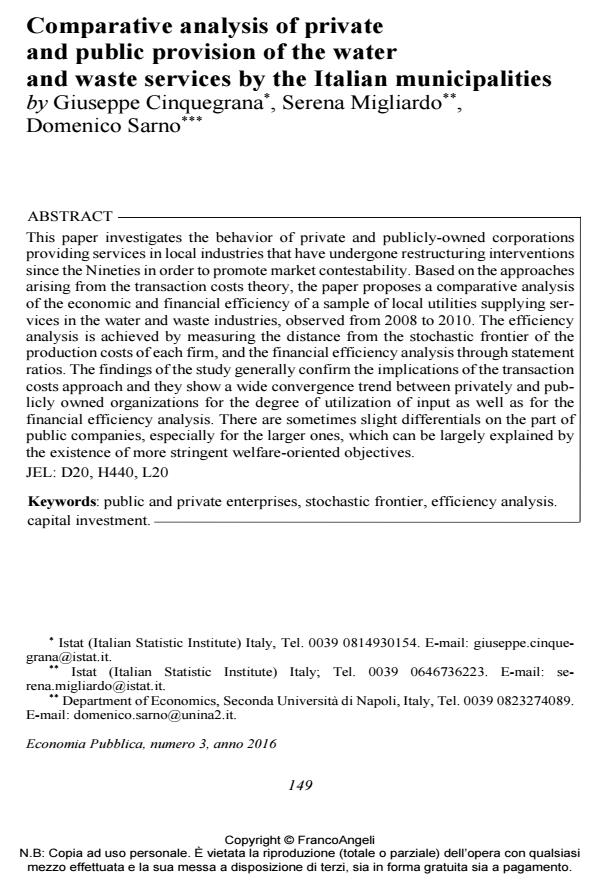Comparative analysis of private and public provision of the water and waste services by the Italian municipalities
Journal title ECONOMIA PUBBLICA
Author/s Giuseppe Cinquegrana, Serena Migliardo, Domenico Sarno
Publishing Year 2017 Issue 2016/3
Language English Pages 28 P. 149-176 File size 303 KB
DOI 10.3280/EP2016-003006
DOI is like a bar code for intellectual property: to have more infomation
click here
Below, you can see the article first page
If you want to buy this article in PDF format, you can do it, following the instructions to buy download credits

FrancoAngeli is member of Publishers International Linking Association, Inc (PILA), a not-for-profit association which run the CrossRef service enabling links to and from online scholarly content.
This paper investigates the behavior of private and publicly-owned corporations providing services in local industries that have undergone restructuring interventions since the Nineties in order to promote market contestability. Based on the approaches arising from the transaction costs theory, the paper proposes a comparative analysis of the economic and financial efficiency of a sample of local utilities supplying services in the water and waste industries, observed from 2008 to 2010. The efficiency analysis is achieved by measuring the distance from the stochastic frontier of the production costs of each firm, and the financial efficiency analysis through statement ratios. The findings of the study generally confirm the implications of the transaction costs approach and they show a wide convergence trend between privately and publicly owned organizations for the degree of utilization of input as well as for the financial efficiency analysis. There are sometimes slight differentials on the part of public companies, especially for the larger ones, which can be largely explained by the existence of more stringent welfare-oriented objectives.
Keywords: Public and private enterprises, stochastic frontier, efficiency analysis capital investment
Jel codes: D20, H440, L20
- Statistics for Innovation IV Serena Migliardo, Giuseppe Cinquegrana, pp.42 (ISBN:978-3-031-96032-1)
- Rationales, performance and governance of public entreprises. Editorial introduction Luc Bernier, Massimo Florio, Johan Willner, in ECONOMIA PUBBLICA 3/2017 pp.5
DOI: 10.3280/EP2016-003001
Giuseppe Cinquegrana, Serena Migliardo, Domenico Sarno, Comparative analysis of private and public provision of the water and waste services by the Italian municipalities in "ECONOMIA PUBBLICA " 3/2016, pp 149-176, DOI: 10.3280/EP2016-003006